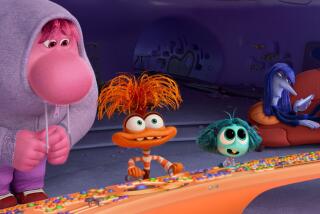‘Total Carnage.’ ‘The Punisher.’ ‘Vendetta.’ Our mild-mannered reporter goes in search of the . . . : Joy of Mayhem
- Share via
The other day, I went to the Sherman Oaks Galleria in search of mayhem. No, no, not the kind you find on the streets of L.A., on television, in movies, on radio talk shows and in speeches by U.S. Atty. Gen. Granite--er, Janet Reno.
I mean artificial mayhem. It’s all the rage (so to speak).
I happily entered the icon of American malls and headed for the Time-Out Family Entertainment Center. That’s where you find mayhem these days--in family entertainment centers. Do I exaggerate? No, I merely report. Consider that one game here bearing the pastoral title “Total Carnage” allows the player to become either Captain Carnage or Major Mayhem. Voila !
Incidentally, Major Mayhem--who is, naturally, a good guy (it makes killing OK)--wreaks horror and havoc via that famed video game tool known as the . . . joystick. Hmm. For a moment, I thought this seemed terribly ironic. Last time I checked, joy and mayhem had little to do with one another. Then it hit me . . .
It’s the joy of mayhem!
No longer is mayhem the privilege of the deranged, rabid, tyrannical, perverted, monstrous and evil. In the ‘90s, nice people can enjoy a little mayhem--a little mass murder, a little decapitation, a little blood and gore. Priests, rabbis, nuns, Girl Scouts--with a few quarters, they too can rip out beating hearts to their own beating hearts’ content.
(Mayhem is cool, Butt-head. Heh heh. Heh heh.)
In search of elucidation on this matter, I spoke with a brilliant guy named Tom McDonough, who lectures on engineering at Caltech and created the best-selling Space Adventure educational computer software. McDonough told me he is very worried about mayhem video because, he said, the games short-circuit the higher functions of the brain--meaning they’re all hand-eye coordination fueled by killer instinct, no analytical thought required.
“I think,” McDonough said, “if we could tap into that kind of lust in a game for educational purposes, we would have a tremendous turnaround in our students’ ignorance.”
I figured McDonough for an optimist.
I also spoke to a guy with a name rather like that of a video game--Parker Page--who is a psychologist and president of the Children’s Television Resource and Education Center in San Francisco. This group has “provided products and services that enhance children’s social development” since 1985.
“Do the games desensitize children to violence?” Page said. “My stock response is that the research is preliminary. I’ve counted less than 12 published studies on the issue of video game violence and its effect on kids. So the jury is still out. But having said that, the preliminary research looks a whole lot like that huge bulk of research we have on TV violence and kids.”
Meaning . . .
“It looks like some kids who have a steady diet of playing violent video games may be more at risk of either being more aggressive with other children in the real world, or more tolerant of the aggression around them. My great hope is that this brouhaha will move a lot of the research people into an action mode to really find out what the effects are.”
Well, the brouhaha moved me into an action mode to really find out what the effects are. I scanned the arcade for available mayhem. Yes, I had come to play! I sought to determine if participation in artificial mayhem might, as some contend, engender a desire to participate in real mayhem. Would a session of, say, “Mortal Kombat” leave me pumped with testosterone, spoiling for a fistfight? Would it bring out what men’s groups call the “hairy wild man” in me? I meant to go about the experiment carefully, engaging in research and observation before undertaking my potentially life-changing experience. . . .
*
Some highlights of my research inside Time-Out:
* Eleven of the 13 games lining one wall--including “Street Fighter II--Hyperfighting,” “The Punisher,” “Fighter’s Story”--were predicated on the joy of mayhem--gouging, smashing, pummeling, shooting, vaporizing, forcibly removing essential body organs and blood, blood, blood. (Don’t worry, it looks like ketchup.) To be fair, of course, most arcades carry the same stuff.
* A sign warned that “No person under 16 years of age is permitted in this establishment during school hours. No smoking, no gambling, no food or beverages, no loitering.” I thought this was good. You don’t want kids engaged in video decapitation and mutilation to develop bad habits. The great seal of the FBI also caught my eye, flashing on a video screen. A copyright warning? No, it seems that after finishing your carnage of choice, the great seal ominously appears, along with the words: Winners don’t use drugs.--William B. Sessions, FBI Director. Perhaps not, I thought, but in video games, they sure use a lot of guns.
* A gawky kid about 11, with thick glasses and gigantic Nikes, was heavily engaged in the remarkably realistic-looking “Mortal Kombat.” He slapped the many “Kombat” buttons with the same speed and certainty that Ricky Ricardo used to slap congas. He “touch-fought,” never even glancing at the buttons as “Sub-Zero” decapitated a female combatant whose body collapsed lifelessly in its own gushing blood. The kid played many rounds of “Kombat,” ripping out hearts, cutting off heads. When he lost, he spanked the machine and stomped his foot. Hard.
* A game called “Lethal Enforcers,” from Konami. This contest features a brawny man and bosomy woman in various cops-and-robbers shootouts. The instructions suggest an effort to instill moral values in the player: “Don’t shoot the innocent bystanders,” they declare. “Shoot the enemy!” Without a doubt, this is an important life lesson for the late 20th Century. “Lethal Enforcers” seems to be won by how many lives the player can “take.” You lose a life by shooting an innocent bystander. And, in a kind of video game Karma, you “earn extra lives with high-point scores.” A full on-screen description of available weapons lists: “Magnum--large-caliber bullets, automatic, 12-round bullets; assault rifle, three-shot bursts; shotgun, large gauge; machine gun, full automatic; grenade gun, explosives.” The game was played with life-size simulated revolvers in attractive pink or blue.
* “Vendetta,” also from Konami. This game stars tattooed strong guys with big sawed-off shotguns blowing away other tattooed strong guys. The Dead End Gang battles the Cobra Gang as flaming trash barrels are hurled, Molotov cocktails are dropped from windows, shotguns are fired and, in a touch Madonna would appreciate, a dominatrix in skimpy leather underwear appears and horsewhips everybody. I sort of enjoyed that part.
*
A young fellow interrupted my note-taking to ask if I needed help. I guess I looked suspicious, standing there peaceably instead of indulging in mayhem. It was Pat Harker, the assistant manager of Time-Out. Pat told me that “the more violent games we’ve got are the most popular,” and added, with a trace of disgust: “I guess this says something about our society.”
Still, Pat is a big fan of the violent games--not for the gore, but for the high degree of difficulty. What’s more, he said, they help “release stress and anxiety”--particularly if you visualize someone you know: “It’s just like hitting your boss, or chopping him up,” he said with a laugh. I made a note of that.
I paused to chat with a couple of players, for additional insight. Lohren Price, 16, of Culver City was playing “The Punisher.” Clad in gigantic shorts, a T-shirt and a baseball cap pulled way down over his eyes, Price said he plays games every weekend--usually about $5 worth. “I’ve heard people say, ‘Wow, that is kind of graphic,’ ” he said. “I don’t think it’s too graphic. Not really. I mean, everybody sees this kind of thing every day on TV and in movies. If (little kids) don’t get it here, they’ll get it somewhere else.”
I had to agree.
Then I spoke to a not-too-friendly guy about 35, whom I had spotted earlier playing “Mortal Kombat” with that weird, splayed-leg stance favored by serious competitors. “I just like playing video games,” he said, declining to give his name. “Violence doesn’t play that big a part in drawing me. ‘Street Fighter’ is the biggest in the market right now, and it requires a great degree of skill. The blood and death doesn’t bother me. It’s a violent world we’re in. Blood’s a part of it. Death is a part of it. Everybody dies.”
His fatalism was impressive.
“And anybody who takes these games as real life,” he added, “has got a screw loose! It’s not real life--it’s a video game!”
Not to worry, he--and Harker and Price--seemed to be telling me. After all, it’s just a game. As one lunching businessman in the Galleria had told me earlier: “It’s not real mayhem. It’s McMayhem. McDeath. McMaiming. After you McKill for a while, you take the escalator downstairs to McDonald’s and have a Big Mac.” The not-too-friendly guy’s words echoed in my head. It’s not real life, it’s a game!
*
All right, I was ready to play.
I settled on “Street Fighter II--Hyperfighting,” because the gawky kid with glasses was still abusing “Mortal Kombat.”
Please understand that I have never had a taste for violence. At least not since the fourth grade, when a burly classmate named Mark Lockman pounded me at the bus stop after school. (I had called him “Mark Lockjaw.”)
I deposited my quarter. At first, I couldn’t figure out what I was doing. I tried, as McDonough described, to short-circuit the higher functions of my brain and tap into hand-eye coordinated killer instinct, but it wasn’t working. I frantically pressed buttons, enabling jabs, low kicks, flips and all manner of other assaults. I had selected a character called Zangief of Russia because, the game informed, “a pile-driver or brain-buster from his mountainous body is nearly unwithstandable.” That sounded good. Under my guidance, Zangief fought willy-nilly. He swung at imaginary enemies. He kicked at moths. He was a washout, going down repeatedly to humiliating defeat.
So I switched, becoming a girl with pigtails. Women, I have found, can be deceptively powerful. I can’t remember the girl’s name, so I’ll call her Heidi. She was soundly trounced by an ugly brute called Dhalsim of India--once, twice, three times. I found myself feeling guilty. It was the chauvinist in me, I suppose--I should have protected her better! Full of resolve, I randomly and spastically hit buttons even faster.
And then, somehow, Heidi defeated Dhalsim! Was I developing skill? I retired Heidi safe and sound and tried my luck with another character named Ryu. I tried slapping those buttons like Ricky Ricardo. It did no good. Under my guidance, Ryu was beaten so badly so many times that I gave up. I felt as if I was letting him down. And then, in an astonishing twist, the machine took to deliberately taunting me.
The following words appeared on screen: YOU LOSE! SEEING YOU IN ACTION IS A JOKE!
Frankly, the taunt made me feel proud. It was the answer I had sought; my experiment was over. Playing the mayhem games had failed to turn me into a beast. My gentle nature and lack of killer instinct had, in fact, left the machine flustered, reduced to shouting insults at me.
Ha!
More to Read
The biggest entertainment stories
Get our big stories about Hollywood, film, television, music, arts, culture and more right in your inbox as soon as they publish.
You may occasionally receive promotional content from the Los Angeles Times.










